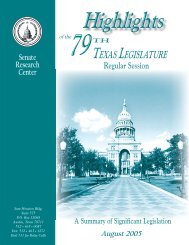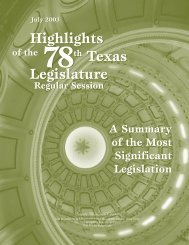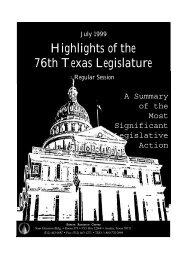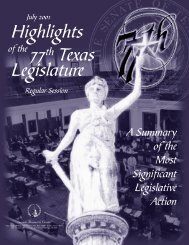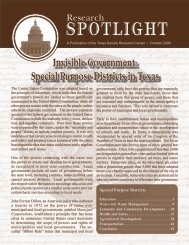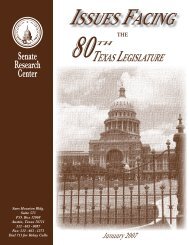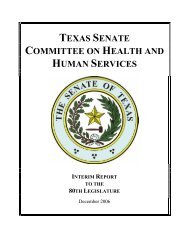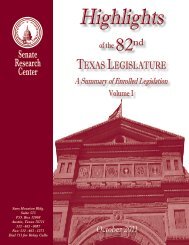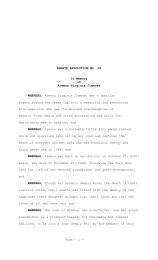Parole, Then and Now - Senate
Parole, Then and Now - Senate
Parole, Then and Now - Senate
You also want an ePaper? Increase the reach of your titles
YUMPU automatically turns print PDFs into web optimized ePapers that Google loves.
<strong>Parole</strong>:<br />
&<br />
<strong>Then</strong><br />
<strong>Now</strong><br />
by inmates. Offenders who were released by a parole board during 1996 served 29 percent of their sentence, <strong>and</strong> other conditional<br />
releases served 47 percent of their sentence. Offenders released in 1996 by a parole board had an average sentence of 79 months, <strong>and</strong><br />
offenders released in 1996 via other conditional releases had an average sentence of 47 months. This does not mean that parole boards<br />
were easier on offenders released in 1996, rather that offenders released by a parole board had been sentenced to serve 32 months longer<br />
than other conditional releases.<br />
Conclusion<br />
The changes in the criminal justice system in the last twenty-odd years that find offenders serving<br />
substantial portions of their sentence reflect a confluence of conservative <strong>and</strong> liberal politicians who<br />
view falling crime rates as evidence that things must be working. Although lawmakers view these<br />
results with satisfaction, their cause is not as clear. On the one h<strong>and</strong>, some scholars <strong>and</strong> politicians<br />
attribute longer sentences for criminals to the abolishment of parole. On the other h<strong>and</strong>, statistics<br />
show this is not necessarily the case. Allen Beck, chief of corrections statistics at the Bureau of Justice<br />
Statistics, recently observed that ending parole by itself “has no real impact on time served.” Bureau<br />
of Justice Statistics data reveal no obvious relationship between type of release (m<strong>and</strong>atory v. parole<br />
boards) <strong>and</strong> actual length of time spent in prison prior to release. Time served in prison has increased<br />
in recent years, but this is attributable to the implementation of truth-in-sentencing laws, not the<br />
abolishment of parole boards. Some states have abolished parole <strong>and</strong> gone to determinate sentencing,<br />
others have renamed parole, while others, like Texas, have kept their parole boards, which serve as<br />
strict guardians of the prison population, <strong>and</strong> rarely release offenders. The constant that has put criminals<br />
in prison longer is the truth-in-sentencing movement <strong>and</strong> the “get tough on crime” attitude of the<br />
populace, not the abolishment of parole.<br />
—by Todd Reimers, SRC<br />
Sources<br />
Books<br />
Petersilia, Joan. <strong>Parole</strong> <strong>and</strong> Prisoner<br />
Reentry in the United States. Forthcoming<br />
in Underst<strong>and</strong>ing Prisons:<br />
Performance <strong>and</strong> Policy Options.<br />
Chicago: University of Chicago Press,<br />
1999.<br />
Burke, Peggy B. Abolishing <strong>Parole</strong>:<br />
Why the Emperor Has No Clothes.<br />
Lexington, Kentucky: American<br />
Probation <strong>and</strong> <strong>Parole</strong> Association,<br />
1995.<br />
Camp, Camille Graham, <strong>and</strong> George<br />
M. Camp. The 1998 Corrections<br />
Yearbook. Middletown, Connecticut:<br />
Criminal Justice Institute, Inc., 1998.<br />
Government Publications<br />
Ditton, Paula M., <strong>and</strong> Doris James<br />
Wilson. State Sentencing Law<br />
Changes Linked to Increasing Time<br />
Served in State Prisons. Online: http://<br />
www.ojp.usdoj.gov/bjs/pub/press/<br />
tssp.pr, accessed on March 9, 1999.<br />
Ditton, Paula M., <strong>and</strong> Doris James<br />
Wilson. Truth in Sentencing in State<br />
Prisons. Online: http://<br />
www.ojp.usdoj.gov/bjs/pub/pdf/<br />
tssp.pdf, accessed on March 9, 1999.<br />
Periodicals<br />
Butterfield, Fox. “Eliminating <strong>Parole</strong><br />
Boards Isn’t a Cure-all, Experts Say.”<br />
New York Times 10 Jan. 1999.<br />
Lyons, Donna. “Truth in Sentencing.”<br />
National Conference of State Legislatures<br />
- Legisbrief. 7.21 (1999) 1-2.<br />
Phone Interviews<br />
Ecker, Alan, Arizona Community<br />
Corrections Division<br />
Maddock, Tom, Colorado Division of<br />
Adult <strong>Parole</strong><br />
Rieger, Chris, Kansas Sentencing<br />
Commission<br />
Madler, John, North Carolina Department<br />
of Corrections<br />
Rauschenberg, Fritz, Ohio Criminal<br />
Sentencing Commission<br />
Goodman, Roger, Washington Sentencing<br />
Guidelines Commission<br />
<strong>Senate</strong> Research Center 8 May 1999



